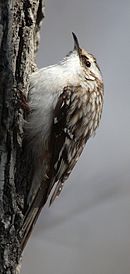Treecreeper
| Treecreepers | |
|---|---|
 |
|
| Brown creeper (Certhia americana) | |
| Scientific classification | |
| Kingdom: | Animalia |
| Phylum: | Chordata |
| Class: | Aves |
| Order: | Passeriformes |
| Superfamily: | Certhioidea |
| Family: |
Certhiidae Leach, 1820 |
| genera | |
The treecreepers are a family, Certhiidae, of small passerine birds, widespread in wooded regions of the Northern Hemisphere and sub-Saharan Africa. The family contains ten species in two genera, Certhia and Salpornis. Their plumage is dull-coloured, and as their name implies, they climb over the surface of trees in search of food.
Most species of treecreeper occur in the Palearctic and Indomalaya ecozones, from Western Europe to Japan and India. One species occurs in North America from Alaska to Nicaragua and another has a discontinuous distribution in sub-Saharan Africa and India. All species of treecreeper are found in forest and woodland habitats. The more northerly species are partly migratory, and those found in warmer climates are thought to be resident, although information is lacking for many species.
Treecreepers measure from 12 to 18 centimetres in length. Their bills are gently down-curved and rather long, used for probing bark for insects and spiders. They often climb up tree trunks in a helical path, hopping with their feet together; their toes are long and tipped with strongly curved claws for gripping. The longer tails of the Certhia treecreepers are stiffened to use as a prop while climbing, but those of the spotted creeper are shorter and not stiffened. Their songs and calls are thin and high-pitched.
Treecreepers are generally unobtrusive and are often indifferent to humans. They occur as singles or in pairs, sometimes in small family groups after fledging. Communal roosting has been observed in three species (and may occur in more), with as many as 20 birds sharing a roosting hole in order to conserve warmth.
...
Wikipedia
